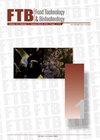Optimization of Thermoultrasound Process of a Soursop (Annona muricata) Nectar and Its Comparison with Pasteurization on Physicochemical Properties and In Vitro Bioaccessibility of Antioxidants
IF 2.5
4区 农林科学
Q3 BIOTECHNOLOGY & APPLIED MICROBIOLOGY
引用次数: 0
Abstract
Research background. Soursop nectar contains antioxidants and for its conservation the pasteurization is applied. However, this technology decreases its physicochemical properties and bioactive compounds, hence, an alternative is the thermoultrasound which could counter these effects. Therefore, the thermoultrasonicated nectar was compared to a pasteurized one and the in vitro bioaccessibility of antioxidants was estimated. Experimental approach. The soursop nectar (25 %) was elaborated and the response surface methodology was used. The thermoultrasound (TUS) (75-90 % amplitude; 3.15-15 min) was applied, and 2 % stevia and 6 % of agave inulin were added as sweeteners. The microbiological, physicochemical, enzymatic and antioxidant properties were analyzed. The nectar was prepared again and control, optimized TUS and pasteurized were compared. In addition to the aforementioned determinations, microstructure, total dietary fiber (TDF) and in vitro bioaccessibility of antioxidants were performed. Results and conclusions. The response variables that fit the mathematical model were L*, b*, Chroma (C*), total phenolic content (TPC), antioxidant activity by ABTS•+, DPPH• and ferric reducing antioxidant power (FRAP). The L* and DPPH• were influenced by quadratic time and TPC by time (p<0.0001). The optimal TUS condition was 82 % amplitude at 9.15 min and the responses variables were L*, b* and C* (45.48, 3.55 and 3.62, respectively), TPC (38.40 mg GAE/100 mL), ABTS•+ (31.28 μmol TE/100 mL), DPPH• (124.22 μmol TE/100 mL) and FRAP (3.06 μmol Fe (II)/100 mL). In comparison with the pasteurized sample, optimized TUS had high value of TDF (3.53%), L* (45.56) h° (-56.49), TPC (26.63 mg GAE/100 mL), ABTS•+ and DPPH• (22.03 and 129.22 μmol TE/100 mL, respectively), FRAP (3.10 μmol Fe (II)/100 mL) and low pectin methylesterase activity (0.28 PMEU/mL). For in vitro bioaccessibility, the optimized TUS nectar showed high absorption of TPC (15.26 GAE/100 mL) and high values in the antioxidant activity by ABTS (34.92 μmol TE/100 mL) and FRAP (7.88 μmol Fe (II)/100 mL). Novelty and scientific contribution. The thermoultrasound improves the physicochemical properties and in vitro bioaccessibility of antioxidants soursop nectar. On the other hand, as an alternative, this beverage provides low-calorie with prebiotic properties for the benefit of consumer health.酸浆(Annona muricata)花蜜热超声工艺的优化及其与巴氏杀菌法在抗氧化剂的理化性质和体外生物可及性方面的比较
研究背景。番荔枝花蜜含有抗氧化剂,为了保存这种物质,需要采用巴氏杀菌法。然而,这种技术会降低其理化特性和生物活性化合物,因此,热超声波是一种替代方法,可以抵消这些影响。因此,我们将经过热超声处理的花蜜与经过巴氏杀菌处理的花蜜进行了比较,并估算了抗氧化剂的体外生物可及性。实验方法。实验采用了响应面方法,对酸浆果花蜜(25%)进行了阐述。使用热超声波(TUS)(振幅 75-90%;3.15-15 分钟),并添加 2% 甜菊糖和 6% 龙舌兰菊粉作为甜味剂。对其微生物、理化、酶和抗氧化特性进行了分析。再次制备花蜜,比较对照组、优化 TUS 组和巴氏杀菌组。除上述测定外,还进行了微观结构、总膳食纤维(TDF)和抗氧化剂体外生物利用率的测定。结果和结论符合数学模型的响应变量有 L*、b*、色度(C*)、总酚含量(TPC)、ABTS-+、DPPH- 和铁还原抗氧化能力(FRAP)的抗氧化活性。L* 和 DPPH- 受二次时间影响,TPC 受时间影响(p<0.0001)。最佳 TUS 条件是在 9.15 分钟时振幅为 82%,响应变量为 L*、b* 和 C*(分别为 45.48、3.55 和 3.62)、TPC(38.40 mg GAE/100 mL)、ABTS-+(31.28 μmol TE/100 mL)、DPPH-(124.22 μmol TE/100 mL)和 FRAP(3.06 μmol Fe (II)/100 mL)。与巴氏杀菌样品相比,优化后的 TUS 具有较高的 TDF 值(3.53%)、L* (45.56) h° (-56.49)、TPC (26.63 mg GAE/100 mL)、ABTS-+ 和 DPPH- (分别为 22.03 和 129.22 μmol TE/100 mL)、FRAP (3.10 μmol Fe (II)/100 mL)和较低的果胶甲基酯酶活性 (0.28 PMEU/mL)。在体外生物可接受性方面,优化的 TUS 花蜜显示出较高的 TPC 吸收率(15.26 GAE/100 mL)和较高的 ABTS 抗氧化活性值(34.92 μmol TE/100 mL)和 FRAP 值(7.88 μmol Fe (II)/100 mL)。新颖性和科学贡献。热超声波提高了酸果树花蜜抗氧化剂的理化特性和体外生物可及性。另一方面,作为一种替代品,这种饮料具有低热量和益生元特性,有利于消费者的健康。
本文章由计算机程序翻译,如有差异,请以英文原文为准。
求助全文
约1分钟内获得全文
求助全文
来源期刊

Food Technology and Biotechnology
工程技术-生物工程与应用微生物
CiteScore
3.70
自引率
0.00%
发文量
33
审稿时长
12 months
期刊介绍:
Food Technology and Biotechnology (FTB) is a diamond open access, peer-reviewed international quarterly scientific journal that publishes papers covering a wide range of topics, including molecular biology, genetic engineering, biochemistry, microbiology, biochemical engineering and biotechnological processing, food science, analysis of food ingredients and final products, food processing and technology, oenology and waste treatment.
The Journal is published by the University of Zagreb, Faculty of Food Technology and Biotechnology, Croatia. It is an official journal of Croatian Society of Biotechnology and Slovenian Microbiological Society, financed by the Croatian Ministry of Science and Education, and supported by the Croatian Academy of Sciences and Arts.
 求助内容:
求助内容: 应助结果提醒方式:
应助结果提醒方式:


